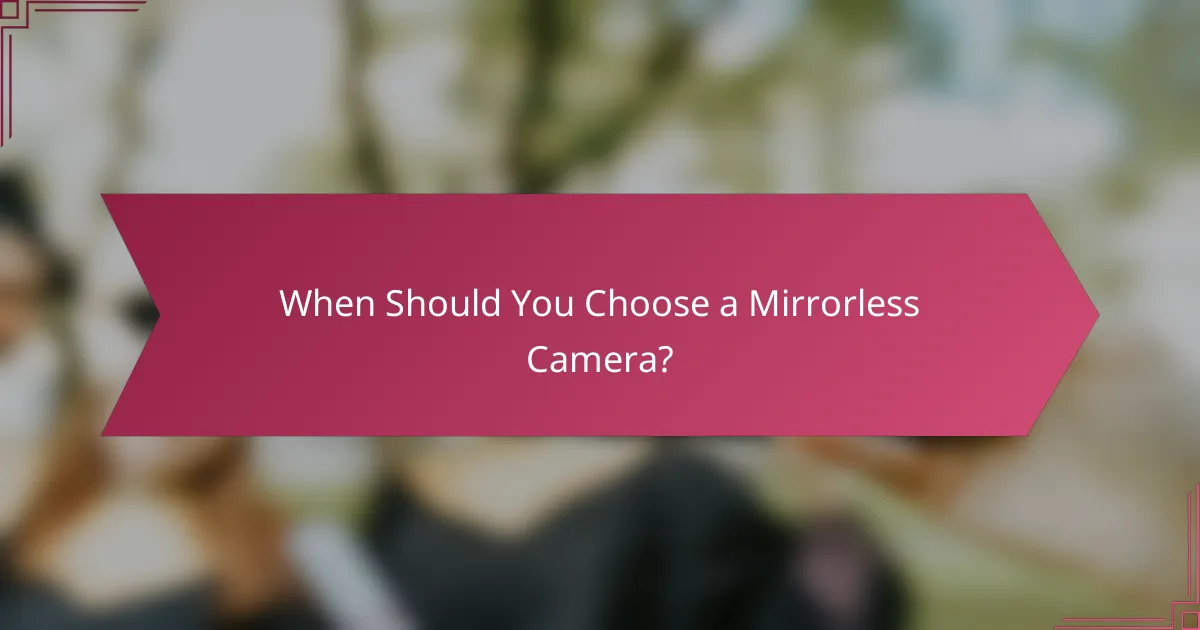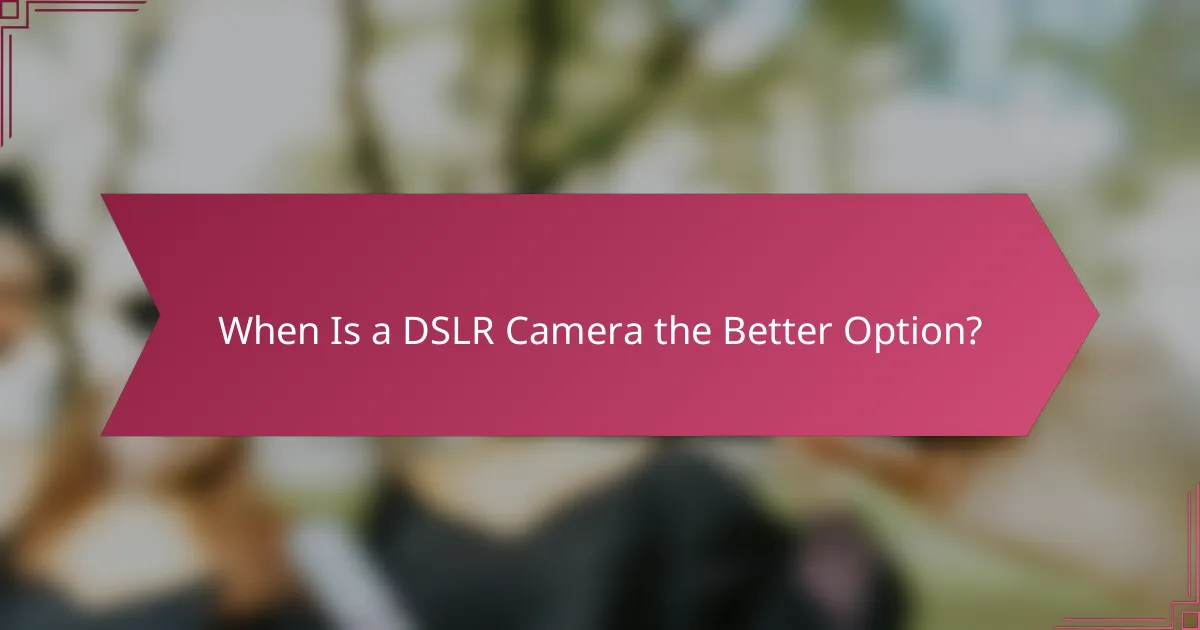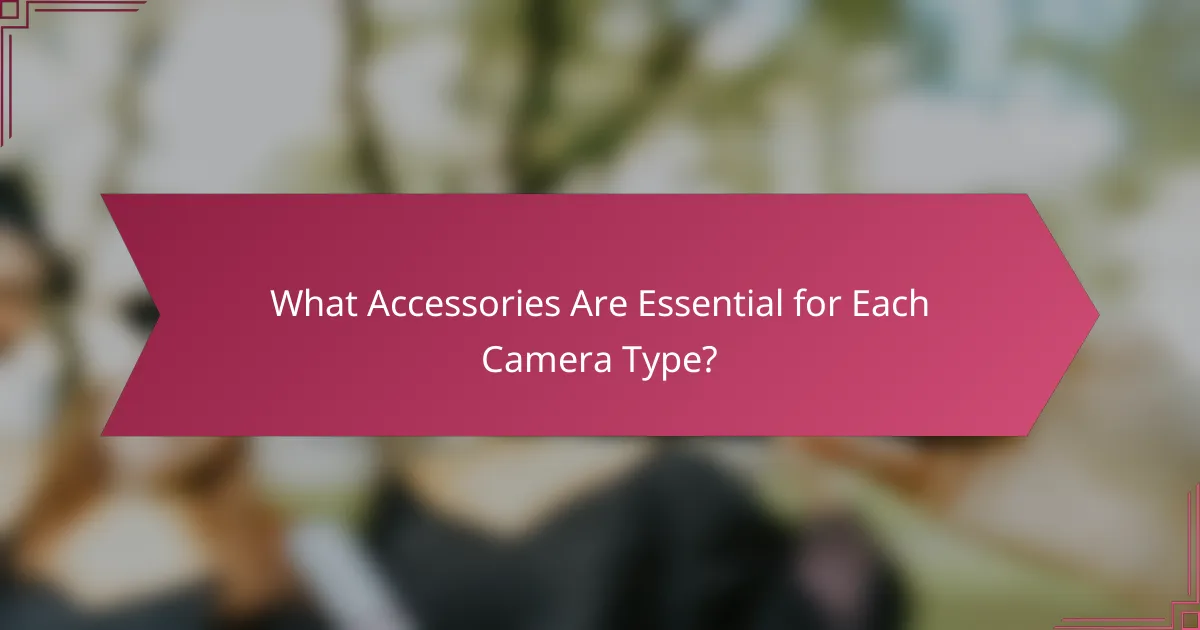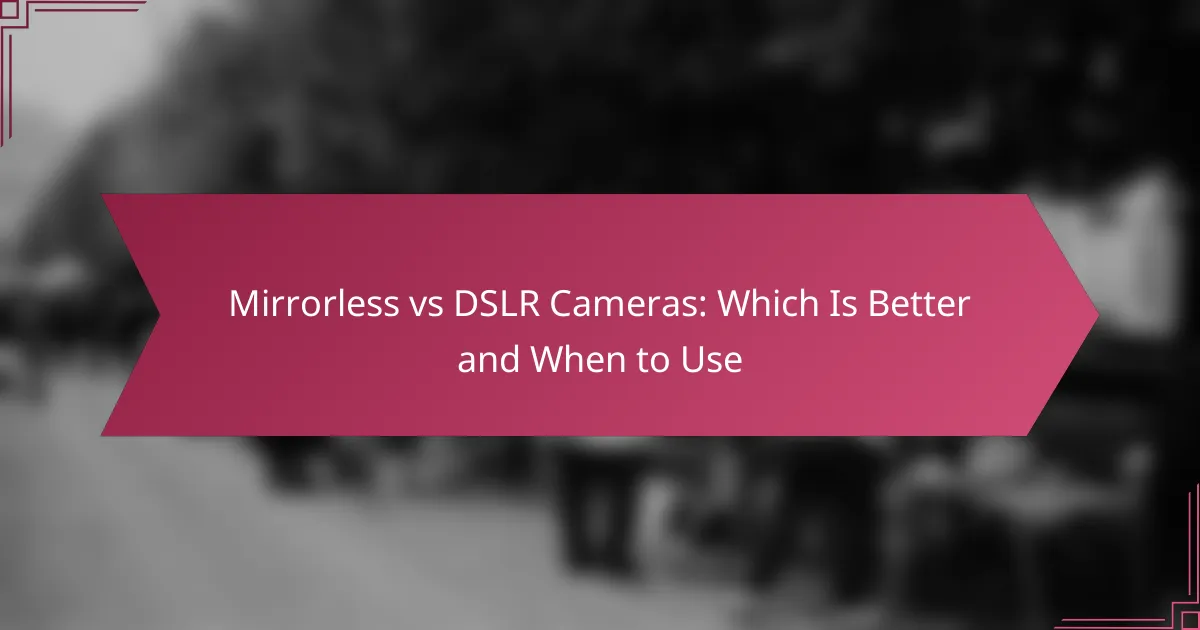When deciding between mirrorless and DSLR cameras, it’s essential to consider your specific photography needs and preferences. Mirrorless cameras are ideal for beginners and those seeking portability, offering user-friendly interfaces and advanced features. In contrast, DSLRs excel in battery life and low-light performance, making them suitable for extended shooting sessions and challenging lighting conditions.

Which Camera Type Is Best for Beginners?
For beginners, mirrorless cameras are often considered the best choice due to their user-friendly interfaces and lighter weight. They provide a simpler transition into photography with intuitive controls and real-time previews of images.
Mirrorless cameras offer user-friendly interfaces
Mirrorless cameras typically feature touchscreen controls and customizable settings, making them accessible for new users. Many models include automatic modes that help beginners capture great photos without needing extensive knowledge of photography concepts.
Additionally, the electronic viewfinder in mirrorless systems displays real-time exposure adjustments, allowing users to see how changes affect the image before taking a shot. This instant feedback is invaluable for learning and improving photography skills.
DSLRs provide optical viewfinders for easier framing
DSLR cameras are equipped with optical viewfinders that offer a clear, real-time view of the scene through the lens. This can be beneficial for beginners who prefer a direct optical experience without the lag sometimes found in electronic displays.
Moreover, DSLRs often have a robust selection of lenses and accessories, which can be appealing for those looking to grow their photography skills over time. The solid build and ergonomics of many DSLRs also provide a comfortable grip for extended shooting sessions.
Budget-friendly options available in both categories
Both mirrorless and DSLR cameras have budget-friendly options that cater to beginners. Entry-level models can typically be found in the range of $400 to $800, making photography more accessible.
When considering budget options, it’s essential to evaluate the total cost, including lenses and accessories. Many brands offer kits that bundle the camera body with a versatile lens, providing a comprehensive starter package for new photographers.

When Should You Choose a Mirrorless Camera?
Choose a mirrorless camera when you need a compact, versatile option that excels in various shooting conditions. These cameras are particularly beneficial for photographers who prioritize portability and advanced features, especially in dynamic environments.
Ideal for travel due to lightweight design
Mirrorless cameras are significantly lighter than traditional DSLRs, making them ideal for travel. Many models weigh less than 500 grams, allowing you to carry them comfortably during long excursions.
When selecting a mirrorless camera for travel, consider models with interchangeable lenses that are also lightweight. This flexibility enables you to adapt to different shooting scenarios without adding excessive weight to your gear.
Great for video recording with advanced features
Mirrorless cameras often come equipped with superior video capabilities compared to DSLRs, including 4K recording and advanced autofocus systems. These features make them a popular choice among videographers and content creators.
Look for models that offer in-body stabilization and high frame rate options for smoother footage. Additionally, many mirrorless cameras support external microphones and headphones, enhancing audio quality during video shoots.

When Is a DSLR Camera the Better Option?
A DSLR camera is often the better choice for photographers who prioritize battery life and low-light performance. These cameras typically excel in situations where extended shooting times and superior image quality in dim conditions are essential.
Superior battery life compared to mirrorless
DSLR cameras generally offer significantly longer battery life than their mirrorless counterparts. While a typical DSLR can shoot several hundred to over a thousand images on a single charge, mirrorless cameras often range from a few hundred to low thousands, depending on usage.
This extended battery life is particularly beneficial for events like weddings or wildlife photography, where changing batteries frequently can be impractical. Photographers should consider this aspect when planning long shoots or trips.
Better performance in low-light conditions
DSLRs tend to perform better in low-light situations due to their larger sensors and optical viewfinders. This allows for faster autofocus and less noise in images captured at high ISO settings, making them ideal for indoor events or nighttime photography.
For example, when shooting in dimly lit environments, a DSLR can maintain image quality with less grain compared to a mirrorless camera. Photographers should leverage this advantage when working in challenging lighting conditions.

What Are the Key Differences Between Mirrorless and DSLR?
The primary differences between mirrorless and DSLR cameras lie in their construction and functionality. Mirrorless cameras use electronic viewfinders for real-time previews, while DSLRs utilize optical viewfinders that reflect light through a mirror system.
Mirrorless uses electronic viewfinders
Mirrorless cameras feature electronic viewfinders (EVFs) that display a digital image of what the sensor captures. This allows photographers to see the exposure, white balance, and depth of field adjustments in real-time, making it easier to compose shots accurately.
Additionally, EVFs can provide various overlays, such as histograms and focus peaking, which enhance the shooting experience. However, battery life can be a concern, as using the EVF consumes more power compared to optical systems.
DSLR relies on optical viewfinders
DSLRs employ optical viewfinders (OVFs) that use a mirror and prism system to reflect light from the lens directly to the viewfinder. This provides a clear, lag-free view of the scene, which many photographers prefer for its immediacy and natural appearance.
While OVFs excel in bright conditions, they do not display real-time exposure settings or focus adjustments. This can lead to surprises in the final image if settings are not carefully monitored.
Autofocus speed varies between the two
Autofocus performance differs significantly between mirrorless and DSLR systems. Mirrorless cameras often use on-sensor phase detection or contrast detection, which can provide fast and accurate focusing, especially in video mode.
Conversely, DSLRs typically rely on dedicated phase detection sensors, which can offer superior performance in low light and during fast action photography. However, advancements in mirrorless technology are rapidly closing this gap, making them increasingly competitive.

How Do Pricing and Value Compare?
The pricing and value of mirrorless and DSLR cameras vary significantly, influencing the decision on which type to purchase. Generally, mirrorless cameras tend to have higher initial costs, while DSLRs offer more budget-friendly options for beginners.
Mirrorless cameras often have higher initial costs
Mirrorless cameras typically come with a higher price tag due to their advanced technology and features. For instance, many models start in the mid to high hundreds of USD, with premium options reaching into the thousands. This investment often reflects superior image quality, compact design, and faster performance.
When considering a mirrorless camera, factor in additional costs such as lenses and accessories, which can add significantly to the overall expenditure. It’s essential to evaluate whether the benefits align with your photography needs and budget.
DSLRs provide more affordable entry-level options
DSLR cameras are known for their affordability, especially for beginners. Many entry-level DSLRs are available for under 500 USD, making them accessible for those just starting in photography. These cameras often include essential features and a robust selection of lenses at reasonable prices.
While DSLRs may lack some advanced features of mirrorless systems, they offer excellent value for novice photographers. Consider purchasing a kit that includes a lens to maximize your investment and ensure you have the necessary tools to start capturing images right away.

What Accessories Are Essential for Each Camera Type?
Essential accessories for mirrorless and DSLR cameras differ mainly due to their design and functionality. Understanding these accessories can enhance your photography experience and ensure you have the right tools for your specific camera type.
Lenses vary significantly between systems
The lens options for mirrorless and DSLR cameras are distinct, impacting the overall versatility and performance of each system. Mirrorless cameras often utilize smaller, lighter lenses, which can be advantageous for travel and portability.
On the other hand, DSLRs typically have a broader selection of lenses available due to their longer presence in the market. This includes specialized lenses for various photography styles, such as macro or telephoto, which may not yet be as prevalent for mirrorless systems.
When choosing lenses, consider factors like aperture size, focal length, and compatibility with your camera body. Investing in quality lenses can significantly improve image quality and creative options.
